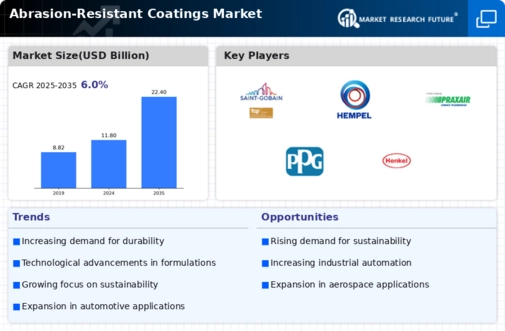Market Analysis
In-depth Analysis of Abrasion Resistant Coatings Market Industry Landscape
The dynamics around which abrasive-resistant coatings operate as they seek alternative solutions for surface protection from wear are changing greatly. The traction gained by abrasion resistant coatings surpasses many other sectors because they withstand frictional forces, impacts and abrasive ones. One major factor altering the course of events within this industry is the need for longer equipment life and lower maintenance costs for industries. Sectors such as manufacturing, mining or construction depend on machines/equipments exposed to harsh environments considering that hard coatings are essential in reducing wear and tear. Manufacturing sector’s need for strong and durable components is the key driver behind abrasion-resistant coatings. Since industrial machinery is continually exposed to abrasive materials, wear and tear has become a significant problem facing its continuous operation. For instance, they act as protective barrier that extends the lives of machinery parts like conveyors, machine parts or cutting tools. Thus, by decreasing maintenance periods and equipment replacement frequencies, their employment in production process helps save on operational costs while raising Overall Equipment Effectiveness (OEE). In the mining industry, the dynamics of the abrasion-resistant coatings market play an important role in mitigating challenges posed by abrasive materials encountered during extraction as well as processing. Abrasion resistant coatings are necessary for mining equipments such as crushers, chutes, and pipelines which often get damaged due to abrasions leading to drop in efficiency levels and high maintenance costs. Consequently, these are used to acquire them durable shields against abrasive wears hence enhancing durability and performance of any mining equipment. Additionally, construction sector greatly influences the dynamics of abrasion-resistant coatings market. Over time therefore there is always a need to protect concrete surfaces used in constructing buildings roads from wearing out . For this reason abrasion resistant coatings have been adopted for use in protecting concrete floors bridges heavy equipment thus increasing their life spans thereby reducing cases of repairs required in future. The expectation is that as demand for long-lasting protective coats continues rising alongside growth of global construction industry. Besides, the emerging trend of environmental sustainability is a dynamic of abrasion-resistant coatings (ARC) industry. The market demand is shifting towards ARC that can offer superior protection while at the same time complying with eco-friendly standards. Water-based and low-VOC (volatile organic compounds) formulations are now becoming popular as stakeholders in this sector strive to find eco-friendly solutions that meet strict regulatory requirements.








Leave a Comment